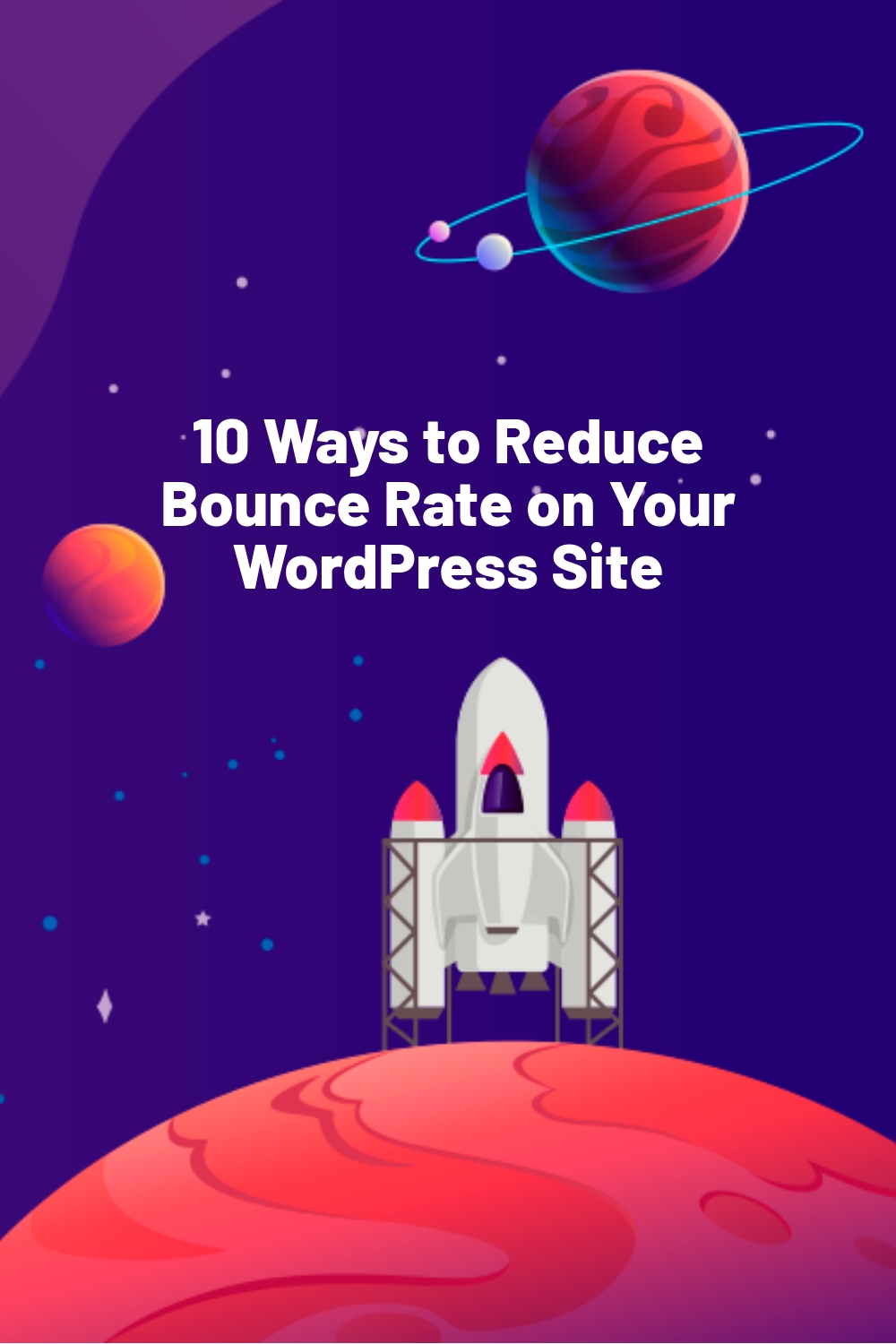WPLift is supported by its audience. When you purchase through links on our site, we may earn an affiliate commission.
10 Ways to Reduce Bounce Rate on Your WordPress Site
WordPress offers a suite of tools for building websites and blogs and is compatible with various analytics packages to improve user experience. Evaluating the quality of the user experience provided by your website is essential for increasing your visibility in search engine rankings, web traffic to your site, and conversion rates for products you advertise or sell. Standard metrics for evaluating the user experience quality are:
- The bounce rate.
- Time on-page.
- Time on site.
- The number of unique visitors.
- Your conversion rate.
In this article, we will discuss how to reduce the bounce rate by improving your website’s user experience.
What is a Bounce Rate?
A bounce is a website visit where a visitor enters and exits the website on one page without navigating to an internal page or resource. Analytics software computes a percentage of site visits that result in a bounce, the result being the bounce rate. When investigating how to improve bounce rate, it is crucial to understand what bounce rate does not measure. Notably, the bounce rate does not measure the amount of time a user spends on a web page or whether they found the page helpful. Instead, bounce rates measure how successful your landing pages are at getting a user to take action – navigate to an internal resource – before leaving the website or closing their browser.
What is a Good Bounce Rate?
Typically, a bounce rate of under 50% is considered excellent. This means that 1 out of every two website visits will result in a visitor navigating to at least one of your internal pages. For eCommerce sites, these internal pages could include a user cart for making a purchase, while for informational blogs, these could consist of other blog posts on the website.
So, what is a reasonable bounce rate? 2020 saw an uptick in eCommerce and online marketing. With an increase in businesses allocating resources for online marketing, maintaining an above-average bounce rate may become more complicated, resulting in the standards of a reasonable bounce rate decreasing from below 70% to below 50% to possibly below 34% sometime in the future. Regardless of the increasing competition for user attention, any website owner can improve their bounce rate by implementing a thorough content strategy.
10 Ways to Reduce Your Bounce Rate
Website owners often ask, “How can I lower my bounce rate?” Although there is no single approach for reducing bounce rate, focusing on creating engaging content on your landing pages which prompts visitors to fulfill a need by navigating to an internal page (e.g., to answer a query that brought them to your website), is essential when deciding how to lower bounce rate in your website. Hook visitors with engaging content and drive them to explore your website to learn more, purchase your products, or enter a subscription list. Learning how to reduce your website’s bounce rate does not have to be difficult, expensive, or time-consuming. Here are ten aspects of your website that you can modify to reduce bounce rate while improving your user experience.
1. Optimize Page Load Time
Your first opportunity to engage a reader is when your page loads. To make an excellent first impression, your page needs to load quickly, ideally in under a second. As load times increase, user attention spans are exhausted, and frustration levels rise. At an extreme, a user may leave your page before it fully loads, causing an immediate bounce before you had the chance to engage them.
Here are some ways to improve page load times:
- Compress stored image files
- Store multimedia off-page
- Pre-load a light version of your page
- Upgrade your Webhosting plan
- Use a content distribution network
Images and multimedia items are beautiful ways to engage your content viewers; however, if large file sizes are slowing the load time of your page, then your viewers may bounce before ever getting a chance to appreciate your amazing graphics. Consider compressing high-resolution images and storing multimedia items off-page. Streaming video from a torrent is often faster than loading the entire video file within a webpage.
In addition. for media-heavy pages, pre-load a reduced-memory version of your page, which visitors can use during memory-intensive media items load. Also, consider upgrading your web hosting plan to get access to faster servers with more available bandwidth. You can also use a content distribution network, such as Amazon Web Services, to have access to a global chain of servers which can provide a quicker, localized distribution of your web content to site visitors.

Article Continues Below
2. Smart Formatting
Organization is crucial to create a positive first impression with website visitors and in making your webpages inviting and easy to understand. Ideally, your pages’ layout and format should enable your viewers to capture the significant content points provided quickly. The easier it is for a user to identify what content is offered on each page, the more likely they are to find helpful information and stay on your website while navigating through your internal link structure.
Here are some helpful ideas for formatting your web pages when considering how to reduce bounce rate:
- Use headers and various levels of sub-header which delineate your content
- Bullet lists of items
- Keep your font consistent
- Justify or left indent your paragraphs
Headers guide readers to sections of your webpage while providing a topical focus. By reading headings and sub-headings, visitors can focus their attention on each page’s sections, which are most helpful to them, without the need to read every word.
Another important formatting tool is bulleted lists. These make reading lists of items more accessible and help organize content within a heading or subheading. In addition to bulleted lists, consider using a consistent font structure and justifying and/or left indenting each paragraph to create consistency throughout the webpage, thereby increasing the visual appeal and user engagement.
3. Make Your Content Readable
Most web content is text-based. From sales copy to informational blog posts, the text is an essential mode of communication on the internet. Readability is crucial in text-based content. Providing readable content is vital for getting a user to stay on your webpage and click through to an internal resource, thereby reducing your bounce rate. To improve readability, avoid large blocks of text. These are off-putting to readers unfamiliar with your content, and many readers may choose not to wade through the block of text to identify helpful information. Instead, break content into small paragraphs of only a few lines.
When considering how to lower bounce rate, remember that good writing techniques are also applicable to creating engaging web content. Try to begin each of your paragraphs with a topic sentence that indicates the information provided in the paragraph and end each paragraph with a quick summary sentence that leads into the subject of the subsequent paragraph.
In addition to breaking up paragraphs, select a few important ideas to highlight through your webpage. Using a WordPress plugin or modifying your CSS template, you can accentuate important ideas and quote using larger font sizes, italics, and different font colors. By sprinkling these throughout your text, you can guide a reader to important ideas which may encourage them to read more. By including one or two internal links nearby these highlighted regions of text, you can also prompt a reader to click through to a related internal page, thereby improving your bounce rate.
4. Reduce the Number of Widgets, Pop-Ups, and Ads
Landing pages are important places for engaging your reader and encouraging them to explore your webpage. As visitors view your content, avoid distracting them with graphics, banner advertisements, and pop-ups. These can clog or obfuscate the visible area, thereby blocking your content and encouraging your reader to move to another website. To identify how to decrease bounce rate, look for ways to keep the user focused on the provided content. Distracting pop-ups instead contribute to a below-average bounce rate.
Carefully consider whether advertisements are needed on your landing pages. If you choose to include an ad, ensure that the advertised product relates to the content on your webpage. This improves your credibility and keeps the reader’s attention directed to your page’s topical area of focus. Also, display the ad in a way that flows seamlessly with the page layout and content organization. For example, after a section describing a service, you could advertise a company related to the service. The advertisement should not be larger than the paragraph which clarifies the related product or service and should be displayed in-line or nearby in a page margin.
Pop-ups are an excellent way to build a subscription mailing list. To avoid distracting your visitors, carefully select the time at which the pop-up is displayed. Also, the content of the pop-up message should relate to the webpage content. For example, you could set a pop-up for an email subscription to display after various user actions and timers, such as:
- Scrolling through two-thirds of a page
- Spending 30 seconds on a page
- Hovering over an external link and/or the exit button of the website tab
5. Include Contextual Call-To-Actions
When deciding how to reduce bounce rate, consider using call-to-actions (CTAs). These are an effective way of engaging your site visitors while reducing your bounce rate. CTAs ask a user to take any action based on the content provided by the webpage. For example, an e-commerce call-to-action, such as “Add to Cart”, could direct a user to purchase an item based on information provided in a sales copy on a webpage. Selecting the CTA could redirect users to another webpage to view their cart. This navigation to a second webpage is scored by analytics software as a “visit”.
CTAs can be used effectively in many types of webpages. For instance, a CTA could direct readers to:
- Fill out a contact form
- Complete a subscription
- Purchase an item
- Complete a survey
When the user selects the CTA, the website should redirect them to another webpage to complete the action to receive the “visit” credit from analytics software.
Notably, the CTA should visually stand out so that the user can easily view and click on it. Bright colors, such as red, yellow, and neon green, can contrast the color palette of your website while also highlighting the CTA. The CTA should also be well-positioned for easy viewing. Centering the CTA on the webpage and ensuring white space around the link is often effective.
6. Set External Links to Open in a New Tab
To hold readers engaged and focused on your website content, set external weblinks to open in a new tab. This setting ensures that your website remains open in a tab, helping you to avoid a bounce. Besides, the open tab makes it easy for visitors to return to your website after following external links without needing to search through a chain of backlinks.
Alternatively, consider whether it is possible to embed external content in your webpage to further focus user attention on your website. For example, multimedia items can be played and viewed by embedding a media player in your webpage. Text-based information can be imported to an embedded display on your page.
If you include external links in your web page, consider placing these links lower on the page to give yourself time to establish credibility. The more credibility that you can build with your readers, the more likely it will be that they will want to navigate through your website to answer their initial query. Building a fully connected internal linking structure will also assist user navigation while reducing your bounce rate.
7. Optimize for Mobile
Some site owners maintain websites that are not optimized for mobile devices but wonder, “Why is my bounce rate so high?” With the increased use of mobile devices for internet browsing, websites that are not optimized for display on mobile devices risk high bounce rates due to the possibility of display problems for non-optimized pages on small screens. Webpages should be developed to clearly display devices with medium (e.g., tablets) and small (e.g., smartphones) screen sizes. Important elements to optimize are the location of CTAs, headings and formatting elements, and the page load time for processing power-limited devices.
When displaying web pages on a small screen, the webpage CSS formatting may need adjustment to render the page correctly. Some website themes displayed nicely on a large screen may have visual elements that are partially obscured or positioned skewed right or left of their ideal location on a small screen. In WordPress, you can preview themes and webpages on medium and small screens to identify rendering issues.
Also, consider developing multimedia-reduced versions of your webpages for devices with CPU and GPU constraints. You can modify your theme to load light versions of webpages based on a detected device type. This can improve the user experience while reducing bounce rates.
8. Improve Your Site’s Navigation
To determine how to reduce bounce rate, we need to identify how to receive a “visit” credit by analytics software. Your visitors need to navigate from a landing page to at least one other page in your website to receive a “visit” credit. A clear, visible site navigation menu makes this easy and intuitive for your user. Here are some questions to consider in your menu placement:
- Is the menu positioned above the webpage, to the left, or to the right?
- Is the menu persistent, or does it disappear out of view as the user scrolls?
- Is the menu accessible and user-friendly?
- Is the menu mobile-friendly?
To encourage a click-through to another internal webpage, your navigation menu should be accessible and user-friendly. For example, the menu options should be extensive with clear, readable text. The menu color scheme should also stand out from your website’s color pallet to ensure high visibility. For ease of use, implement a semi-persistent menu that disappears out of view as a user scrolls down but reappears as they scroll up. Finally, ensure that your menu is mobile-friendly; while being visible, the menu should not obscure any webpage content on small screens.
For large websites, consider adding submenus to main menu options to aid users in navigating through your website. In addition, consider adding a search bar to your site navigation display. Performing a search is a quick way for users to find useful materials on your website. Ensure that each of your pages is tagged accurately and completely to ensure that your website’s search functionality works effectively.
9. Target the Correct Audience
Identifying your target audience is crucial to build a successful website and to develop a content strategy that engages visitors and lowers your bounce rate. Carefully consider who are the most likely visitors to your website:
- Are they young or old?
- Are they technology savvy or only marginally computer literate?
- Do they like to read long blog posts, or do they prefer short, informational pieces?
- Are they likely to access your website on the go with a mobile phone or at a desktop computer over a cup of coffee?
The more accurately you can characterize your target audience, the more effectively you can adjust your content strategy to meet their needs and keep them engaged. One method for testing your content strategy is an A/B test (or even an A/B/C test). In operation, you can send half of your users to one page (page A) while sending the rest to a second page (page B). Both pages should present similar content, but the presentation should be slightly different. For example, you could place CTAs with different color schemes on each page. By measuring the per page bounce rate, you could identify which page format or content strategy is more likely to trigger your visitors’ desired action.
Although you may have selected a target audience when you built your website, realize that your audience may change over time. When modifying your content to meet your original target audience’s needs, consider whether there may be additional groups who are benefitting from your content. Always aim to serve a diverse readership. By approaching topics from multiple angles with several articles and providing landing pages and internal link structures for each angle, you can attract a broader readership and keep them engaged for longer.
10. Keep Your Content Fresh
Site visitors navigate to your website with a need that they are looking for you to address via the content on your website. Make sure that you regularly update your landing pages and high-views articles to ensure that the presented information is current and continues to adequately meet the evolving needs of your readership. For your high-views articles, consider adding new webpages that provide additional details on one or two focus areas of the original article. In so doing, you can generate content trees for high-interest topics with articles at varying levels of detail that encompass a range of foci. This enables visitors to choose the level of detail and area of focus that suits their evolving needs and encourages repeat visits.
One way to identify focus areas for your content trees is through keyword research. As popular search queries and people-also-ask queries change, you can add new articles that focus on answering one or two aspects of these new queries. You can also expand your content tree by adding additional landing pages that provide internal links to specific topical-focus branches within your content tree. As the tree grows, remember to update your internal link structure to encourage click-throughs and maintain a good bounce rate.
Over to You
Bounce rate is an important metric for measuring site performance and user engagement. However, identifying how to reduce the bounce rate for your website can be challenging. When evaluated along with indicators, such as time on site, time on page, and the number of visitors, you can infer from an above-average bounce rate that your website delivers useful content to your visitors.
What are some of your approaches for reducing the bounce rate on websites? Have you tried to improve bounce rate by using any of the ten methods presented? Do you have other ideas for how to decrease the bounce rate on websites? Are there approaches that have helped you figure out how to lower the bounce rate for your website? Let us know in the comment section below.











We have to focus on site design, navigation (categories) and site speed.
It helps me much because I want page rank for my new blog.
Thanks!
Virendar
To balance your point about social proof: recent studies have shown that low social proof numbers actually lower user confidence, especially on ecommerce sites. In other words, if all your FB buttons say “1 share” or “0 shares,” you might be better off without them. Low numbers tell readers, “No else wanted to share this.”
Here’s one of those studies: https://visualwebsiteoptimizer.com/split-testing-blog/removing-social-sharing-buttons-from-ecommerce-product-page-increase-conversions/
“Proofread all content before hitting publish and if necessary, employee the services of a professional copywriter.”
Just noting that one because I love irony. ;-) Nice article though, offers good help for a deeper understanding of the bounce rate metric.
Pretty section of content. I just stumbled upon your site and in accession capital to assert that I acquire
in fact enjoyed account your blog posts. Any way
I will be subscribing to your feeds and even I achievement you access consistently quickly.